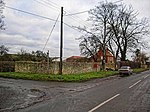Healaugh, Selby
Civil parishes in North YorkshireSelby DistrictUse British English from February 2020Villages in North Yorkshire

Healaugh is a village and civil parish in the Selby District of North Yorkshire, England. According to the 2001 census it had a population of 161 in 63 households. The population had increased to 249 at the 2011 census. The village is about three miles north north-east of Tadcaster.
Excerpt from the Wikipedia article Healaugh, Selby (License: CC BY-SA 3.0, Authors, Images).Healaugh, Selby
Sandawith Lane,
Geographical coordinates (GPS) Address Nearby Places Show on map
Geographical coordinates (GPS)
| Latitude | Longitude |
|---|---|
| N 53.922165 ° | E -1.239898 ° |
Address
Sandawith Lane (York Road)
Sandawith Lane
LS24 8DD
England, United Kingdom
Open on Google Maps







